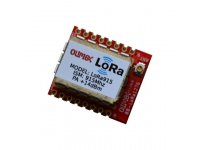≡









LoRa868









LoRa transciever for European ISM frequency 868Mhz
LoRa868 is OSHW certified Open Source Hardware with UID BG0000119
Select Product Variant
- LoRa868
- LoRa868-ANT
- LoRa868-EANT
- MOD-LoRa868
- MOD-LoRa868-ANT
- MOD-LoRa868-EANT
| Price | 8.00 EUR |
|---|---|
| 50 - 99 pcs | 7.84 EUR |
| 100 - 499 pcs | 7.68 EUR |
| 500 - 999 pcs | 7.52 EUR |
| 1000 - 10000 pcs | 7.36 EUR |
868 Mhz is the LoRa frequency for Europe. There are several board variants:
LoRa868 is all in one LoRa modem/transciever with SX1276 and impedance matching schematic
LoRa868-ANT includes +2 dBi PCB antenna with 10 cm cable
LoRa868-EANT includes +3 dBi duck antenna with 10 cm cable
MOD-LoRa868 comes with UEXT connector to directly attach to boards with UEXT
MOD-LoRa868-ANT includes +2 dBi PCB antenna with 10 cm cable
MOD-LoRa868-EANT includes +3 dBi duck antenna with 30 cm cable
IMPORTANT! If you don't have a fitting external antenna make sure to purchase any variant with an antenna. The unit will NOT work without any external antenna!
FEATURES
- SX1276 transciever
- SPI interface up to 10Mhz SCK
- Operating power supply 1.8-3.7VDC (3.3V)
- External antenna u.FL connector
- Operating temperature -40+85C
- Breadboard-friendly
- Distance between connectors: 0.8 inch (20.32mm)
- Dimensions: 0.9 inch (22.86 mm) x 1.023 inch (26mm)
DOCUMENTS
HARDWARE
COMMUNITY
For The Things Network you need to prepare your main board with compatible library. Like:FAQ
- The module doesn't seem to work. What can be wrong?
- Probably wrong hardware connections, make sure to track each wire and consider that you have identified the first and the last pin of each row in reverse. The numbering of the headers on earlier revisions of the schematic was perplexing which might contribute to errors. Try latest schematic for easier orientation.
- Is this stand alone LoRa device that can be attached to thethingsnetwork?
- No. This is only the LoRa transciever module with SX1276 transciever. You need main board programmed with thethingsnetwork library code modified with configuration settings generated in the thethingsnetwork interface. The code for the main board would depend on the exact main board, for most boards the arduino-lmic project should be used. For ESP32 boards we've used ttn-esp32 library succesfully.
- Where are the TTN settings?
- You can't provide TTN settings for a device without main chip.
- The range is very short, a couple of meteres. What could be wrong?
- This is certainly software issue. Make sure to double check the libraries and settings that you use. Try different settings and configuration. If nothing seems to help, test and investigate the software we provide for Arduino IDE or PlatformIO.
One important thing to notice is that PA boost pin is not connected (since we are located in Europe and we don't want to break the laws). This means you have to make sure your RX power is within the range for no PA boost operation. Some software libraries might enable PA boost pin by default, make sure that this is not the case. For example, LMIC uses PA_BOOST mode by default, and you need to disable that, refer to this post




